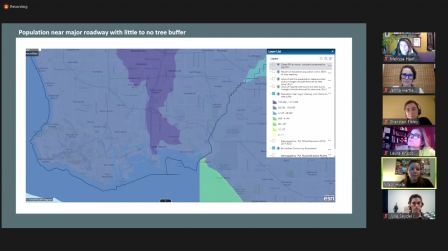Answering the Call: EnviroAtlas Team Supports Teachers and Educators during the COVID-19 Pandemic
 Students in Dr. Melissa Haeffner’s “Environmental Justice” graduate-level course at Portland State University present on their class projects using EnviroAtlas as part of their methodology to explore EJ issues related to populations near major roadways with little to no tree buffer. Guided by EnviroAtlas team members, the students presented their final projects to members of the EnviroAtlas team and other EPA representatives from across the country.Published December 15, 2020
Students in Dr. Melissa Haeffner’s “Environmental Justice” graduate-level course at Portland State University present on their class projects using EnviroAtlas as part of their methodology to explore EJ issues related to populations near major roadways with little to no tree buffer. Guided by EnviroAtlas team members, the students presented their final projects to members of the EnviroAtlas team and other EPA representatives from across the country.Published December 15, 2020
EPA’s response during the COVID-19 pandemic has been broad—ranging from developing an approach for monitoring the virus in wastewater to finding the best approaches for cleaning and disinfection. EPA is also assisting in an unexpected way: helping educators quickly adjust to teaching in the virtual environment.
EPA’s EnviroAtlas team is no stranger to environmental education. Over the past four years they have worked to create educational lesson plans that help K-12 and higher-ed educators incorporate EPA science into their curricula. Starting with the 2016 Building a Greenway Case Study, to the suite of ecosystem services mini-lessons published in early 2020, EnviroAtlas lesson plans on ecosystems, mapping, watersheds, and eco-health connections are aligned with state and Next Generation Science Standards and give students the opportunity to engage with real science, data, and maps from EPA.
As the reality of COVID-19 set in, the need for online-based resources surged. The EnviroAtlas team worked with EPA regions and programs, teachers, and education-focused organizations to not only get educators up to speed on EPA’s existing online educational resources, but also to adapt lesson plans for complete virtual use to meet the new demand. One such partnership came from the Chesapeake Bay Foundation, who hosted a virtual summer course for educators called, “A Right to Nature in the City: The Importance of Urban Environmental Education” that explored an investigation of how natural systems can help communities and schools create change for a greener, more equitable future. The EnviroAtlas team partnered with members of EPA’s Office of Environmental Justice to include environmental justice considerations in their Greenway Case Study educational activity and convert it into a fully virtual format.
Since March, the EnviroAtlas team has planned and implemented over 20 outreach events specifically for educators and learners, with much of their summer efforts focused on the Project PEACE by Youth program (PPBY). Project PEACE was designed to Promote Environmental Action and Community Empowerment by Youth via engaging young people on issues of importance in their own communities and building their capacity to use online tools to understand, explore, and create action plans to address these local issues. The program was envisioned by and co-developed with EPA Region 5’s Environmental Education (EE) Coordinator Megan Gavin and School Environmental Health Coordinator Kara Belle and Illinois educators Paul Ritter and Todd Katz.
The Project PEACE by Youth team held a summer virtual training workshop for teachers to provide resources that could be used throughout the year to empower their students. In particular, EnviroAtlas tools were presented as foundational resources for exploring community issues, even while students are participating in a virtual format. The teachers are now engaging their students in local, place-based problem-solving using the EnviroAtlas tools and resources. Students will present their final projects in Spring 2021. In the meantime, feedback from the participating PPBY teachers has been overwhelmingly positive with comments such as, “This is an amazing resource that makes "big data" accessible to students. They can ask and answer authentic and relevant questions about their communities using EnviroAtlas!” and “The Project PEACE community has become a support group during this crazy time! The positive energy and inspiration I get from the other teachers reminds me of being back in the school building.”
The pandemic has been hard for so many people and professions across the country. EPA continues to assist with scientific research efforts and to respond to other needs, such as those of teachers who are working tirelessly to keep their classroom educational goals relevant, interactive, and impactful for students. When it comes to protecting human health and the environment, we’re all in this together. The newly adapted virtual EnviroAtlas lesson plans will be available online for broad use soon.
Learn more:
EnviroAtlas Educational Materials webpage
Science Matters Article on EnviroAtlas Educational Materials
Questions for the EnviroAtlas team can be directed to enviroatlas@epa.gov.
